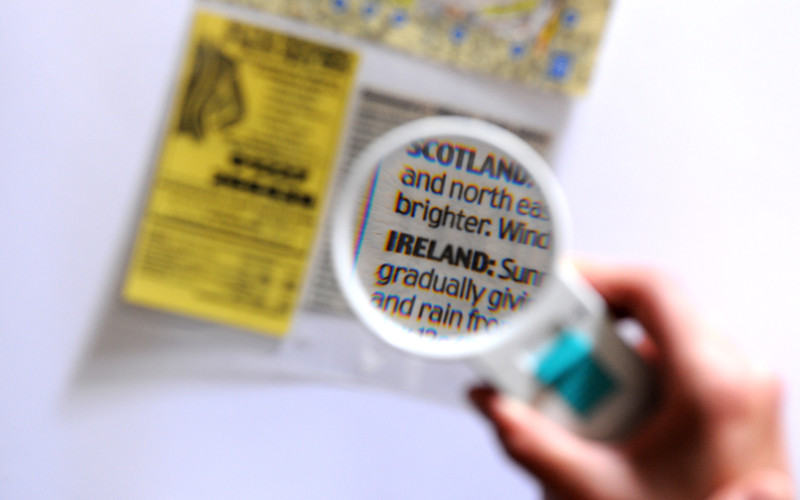So you don’t think you have any low vision patients in your practice?
By Gillian Smith
As a qualified and registered dispensing optician, you are in privileged position to be able to help patients who are visually impaired. According to the Optician’s Act 1989 (The Sale of Optical Appliances), the dispensing of spectacles to patients who are registered as blind or partially sighted, or children under the age of 16, must be carried out by a registered dispensing optician or optometrist. It states that the restriction also includes ‘restricted low vision aids.’
Core competency
Low vision is one of the 12 core competencies specified by the GOC. It is examined in unit 10, a written examination in the Diploma in Ophthalmic Dispensing Syllabus, 2015. It is also examined in unit 12, the practical Final Qualifying Examination (FQE), in section C – prescription analysis (viva) and section D, ocular abnormalities and special optical appliances (stations exam).
By the end of the final year of study, ABDO College diploma students must produce 51 case records for their PQP folder, five of which must be case studies for low vision (LV) patients, at least two of which must be actual dispensings of low vision aids (LVAs).
The Low Vision Honours Course is a specialist low vision course leading to the FBDO (Hons) LV qualification for those qualified and registered practitioners who wish to expand their expertise in the practise of low vision. The course attracts registered dispensing opticians, optometrists and orthoptists.
Those studying for the Low Vision (Hons) qualification must produce comprehensive case studies for 15 low vision patients, comprising of an initial assessment and at least one follow up appointment for each patient after an interval of at least three months, before being eligible to sit the LV (Hons) practical examination. A mix of pathologies and patient ages should be covered.
You may well be asking yourself, why the study of low vision is so important in daily practice if you don’t actually see many low vision patients? According to VISION 2020, an ageing world population will inevitably lead to increased age-related sight loss. However, visual impairment and low vision are not restricted to the elderly.
So what is a low vision patient?
A low vision patient does not have to be certified and registered as Severely Sight Impaired (SSI)/Blind, or Sight Impaired (SI)/Partially Sighted. Low vision is defined in many ways by the different organisations that have an interest in it.
There is no legal definition of low vision. The Low Vision Services Consensus Group, 1999, defines low vision as “a visual impairment which cannot be fully corrected by conventional spectacles, contact lenses or medical intervention and which causes a restriction in that person’s daily life.” The WHO definition is similar but includes field of view. It is worth remembering that a patient with very good central vision, but with a gross peripheral field loss, will be very disabled. If you’re not convinced, find an empty toilet roll or tube, close one eye and put the tube right up to the other eye in contact with the face and brow, now try to navigate around your home or work, not as easy as you might have thought is it?
Pathologies causing low vision
Figures show that the main causes of certification for SSI (blindness) and SI (partial sight) are age-related macular degeneration, glaucoma, diabetic retinopathy, hereditary retinal disorders, optic atrophy and cerebro vascular disease.
Look beyond the common eye pathologies, think laterally and remember that many family members may be affected by the same eye condition, so thorough history-taking will be beneficial in many ways.
Inherited conditions which result in low vision include albinism, aniridia, Best’s disease, cataract, including inoperable and congenital cataract, coloboma, Reis Buckler’s dystrophy and Fuch’s endothelial dystrophy – both corneal dystrophies, Marfan’s syndrome and microphthalmos (associated with congenital rubella).
Dystrophies which affect the macula include retinopathy of prematurity, Best’s disease, Stargardt’s disease, retinitis pigmentosa, Usher syndrome and Leber’s syndrome. Other pathologies resulting in low vision include diabetes (retinopathy may not be stated on the patient record), nystagmus and pathological axial myopia. Stroke patients are often visually impaired by field loss made worse by additional disabilities.
Identifying low vision patients
Research shows that many people fail to identify that they have low vision. Whether it is five or 15 patients you need to find, working in practice offers you a ready patient base, you just need to identify prospective patients and it’s never too early to start the process.
Many strategies can be used. Importantly, talk to your receptionist, or the person who normally books patients in. Make a list of the pathologies that you would like to identify so that you can be alerted if patient records indicate they are coming in for an appointment, perhaps make it a formal list to complete, with headings for pathology, the patient’s name and the date they are attending.
Ask your optometrist if they can alert you to patients, or divert patients to you, who have reduced visual acuities (VAs) or a pathology which may result in visual impairment. Don’t forget to talk to your CLO or optometrist as LV patients also wear contact lenses. Why not make a daily list of patients, recording their pathology and VA for yourself? This is always a good starting point. Always remember that you may have family members or friends who could potentially form part of your patient base.
Further afield
Registered practitioners studying for the LV (Hons) Course can already dispense low vision patients. The provision of LV services varies across the UK and you should become familiar with those who provide low vision services in your area and with local requirements. Contacting your Local Optical Committee (LOC) or Local Optical Committee Support Unit (LOCSU) is a must. Currently it is very difficult for dispensing opticians to find a new placement as a low vision practitioner in the Hospital Eye Service.
Research support societies in your area. You could offer to do some talks, or free assessment sessions for them which will help you to make some relevant contacts. Why not get in touch with your local GP practice and explain that you are studying for a specialist low vision qualification and see whether they may be interested in you coming to talk to patients, or again offer a free assessment session and see where it may lead. The same strategy could also be applied to local care homes.
Are there any special schools in your area? The framework for proposed Special Schools Services advocates that dispensing to children and young adults should be offered within the school environment. You could also consider developing a private specialist low vision practice which would give patients greater choice and improved access to low vision provision. With an overstretched NHS, recall times are often poorly adhered to, with some patients lost in the system. An advantage within practice is that patient reminders and recalls are easier to manage.
It is essential to remember that all your interactions must adhere to the GOC Standards of Practice, ABDO guidelines and the General Data Protection Regulations (GDPR).
Conclusion
The effects of low vision can result in depression, isolation and loss of self-esteem. In children it can also impede social development and educational outcomes, leading to increased social isolation. Effective identification of those affected by low vision and appropriate intervention and support of patients can only result in better provision of care. If patients fail to recognise that they have low vision, it is essential that we as professionals do not fail them.
About the author
Gillian Smith is ABDO College’s senior lecturer and lead lecturer in low vision and anatomy, ABDO practical examiner (Diploma and Low Vision (Hons)), and principal examiner in ophthalmic dispensing theory and associate lecturer at Canterbury Christ Church University.
References:
Advice and guidelines on professional conduct for dispensing opticians appendix D low vision practice: advice to members. Available here (accessed 30 July 2019).
Association of British Dispensing Opticians. 2017. Diploma in Ophthalmic Dispensing Syllabus. 2015.
Association of British Dispensing Opticians. 2018. Level 6 Diploma in Ophthalmic Dispensing. 2015. Guidance for students.
Sinclair A and Ryan B. No date. Low vision: the essential guide for ophthalmologists. The Guide Dogs for the Blind Association.
LOCSU. June 2017. Low vision, habilitation and rehabilitation framework for adults and children. Available here (accessed 30 July 2019.
Vision UK. November 2018. Key facts about vision impairment in children and young people. Available here. (accessed 30 July 2019).
Macnaughton J. 2018. The practical management of visual impairment. Clearview Training.
Bunce C and Wormald R. 2006. Leading causes of certification for blindness and partial sight in England & Wales. BMC Public Health volume 6, article number 58. 2006.
Pollard T L, Simpson J A, Lamoureux E L, Keeffe J E. 2003. Barriers to accessing low vision services. Ophthalmic and Physiological Optics 2003 volume 23, issue 4. Available here.
Bowling B. 2016. Kanski’s Clinical Ophthalmology a Systematic Approach. 8th edn. Elsevier Saunders.
MacEwen C. No date. Eye risk from ‘overstretched NHS.’ Available here (accessed 30 July 2019).
Pictograms-nps-accessibility-low vision access-2.svg. Available here (accessed 30 July 2019).
Eye disease retinitis pigmentosa. Available here (accessed 30 July 2019).







